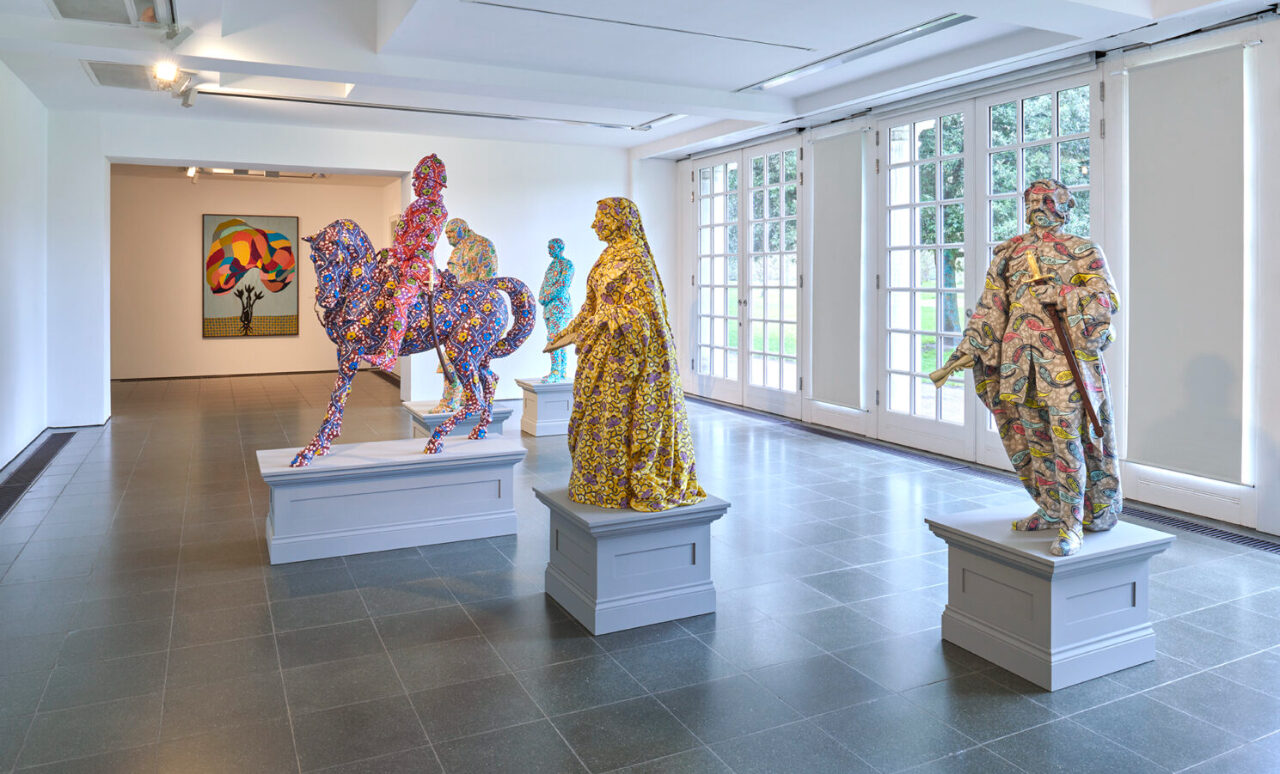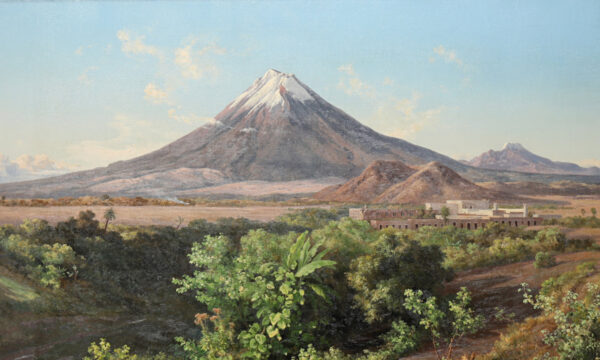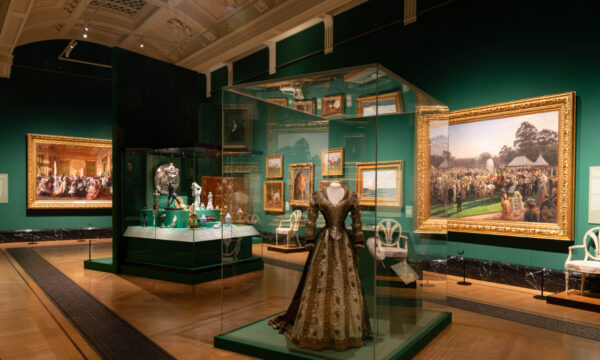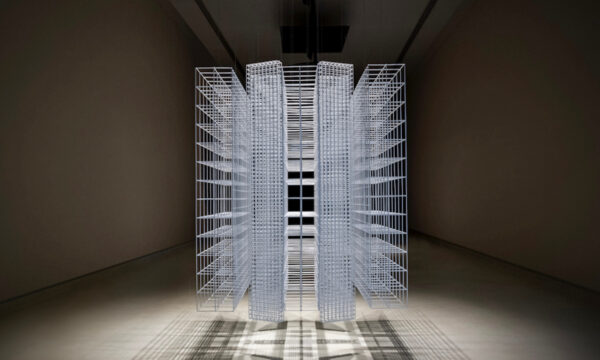Yinka Shinibare CBE: Suspended States at Serpentine Gallery

The legacy of Britain’s colonial past permeates through the work of the British-Nigerian, Yinka Shonibare CBE. Since his student days at Goldsmiths in the 90s, the artist’s practice has seen him explore the effects of the imperial period, alongside migration and the environment. Now, over two decades after his last major solo exhibition in London, his latest show, Suspended States, opens at the Serpentine South Gallery. The Kensington Gardens-based institution holds special memories for the London-born artist, who describes himself as a cultural hybrid, having lived in Lagos during his formative years. He first exhibited there in 1992 as a finalist in the Barclays Young Artists Award and later participated in Serpentine’s 2006 Interview Marathon. The current exhibition will coincide with Shonibare’s work featuring in the Nigerian Pavilion at the Venice Biennale this year.
A Turner prize nominee in 2004, Yinka Shonibare really captured the collective imagination of the British public in 2010 with his Fourth Plinth work, Nelson’s Ship in a Bottle, displayed in Trafalgar Square. The exact miniaturised replica of the legendary Admiral’s flagship, The Victory featured sails made from the Dutch Wax fabric that have long been a common thread in the artist’s practice. For the British-Nigerian, the material carries an intriguing cultural ambiguity. Today, Dutch Wax print has become synonymous with African postcolonial identity. However, it was 19th-century Dutch merchants who originally introduced the fabric to the African continent, having discovered an Indonesian method of printing patterns onto fabric using wax, batik.
Suspended States sees Shonibare continuing to explore the legacies of colonial power and other “pressing” contemporary issues: ecology, migration, homelessness and human conflict. Throughout, one finds recent work incorporating the artist’s Dutch wax print, a metaphor for the complicated history of African and European relations. At the press opening, Shonibare spoke of how, “as an artist, my work is to transform tragedy into beauty” and something of that is borne out in the Serpentine’s first room’s Wind Sculpture in Bronze IV. He captures the spirit of a sail billowing in the wind, hand-painted in orange and turquoise Dutch wax pattern, symbolising the African diaspora and the enslavement of people.
Shonibare casts his questioning eye on current debates surrounding public sculptures of colonial figures with his Decolonised Structures (2022-23). The artist has accorded major imperial personalities, commemorated in grand, often bronze sculptures around London, an altogether more human scale in fibreglass. Removed from its Parliament Square plinth and reconfigured in lifelike proportions, Shonibare’s version of Roberts-Jones’s 1973 sculpture of Sir Winston Churchill sees the British Prime Minister, known to have expressed controversial views on race, similarly reduced in potency. Churchill, like the other British figures rendered in Decolonised Structures, is hand-painted with Shonibare’s Dutch wax pattern designs. Pointedly, only their instruments of colonial subjugation, be it Sir Robert Clive, the first British administrator of Bengal’s sword or Queen Victoria’s clutched document, presumably signifying her dominance over her dominions, are left unpainted. At a time of passionate debate about statues in the public realm, Shonibare holds the view that rather than toppling statues down, platforms should be created to question values of the past now considered abhorrent.
In another room at the Serpentine, one finds another new installation, The War Library. Featuring 5,000 books bound in multicoloured designs of the artist’s signature Dutch wax print, the gold lettering on the spines references the names given to conflicts and peace treaties over the centuries. Each one, from the Bablyonian-Assyrian War of 1235 BC to the 21st century, represents a battle for imperial supremacy. The size of a book doesn’t necessarily reflect the degree of significance historically accorded to the war it denotes. On each shelf one finds the labelled books punctuated with tomes as yet devoid of a title, alluding to bloody wars that inevitably await humanity. The artist attests to the work posing questions related to “human memory and amnesia”, arguing that mankind is forever repeating past mistakes. Research stations have helpfully been set up beside the work to inform visitors about the conflicts and treaties referenced.
The heart of the current exhibition reveals another new installation by Shonibare, Sanctuary City. In a darkened space, one is confronted with miniaturised versions of buildings across the world, both historical and contemporaneous, that have been places of refuge for the vulnerable. The only colour emitted emerges from the Dutch fabrics illuminating their interiors. Notre Dame is instantly recognisable despite the absence of light. Others such as the Chinese Methodist Church, Hong Kong, where protesters sheltered during 2014 pro-democracy demonstrations, and the much criticised Bibby Stockholm, Dorset, where UK asylum seekers have been housed since August 2023, were less readily identifiable. The artist expresses compassion for those seeking refuge and shelter faced with seemingly inhumane authorities.
Elsewhere, one sees Shonibare’s ecological concerns coming to the fore in the quilt African Bird Magic (Mauritius Fody & Comoro Blue Vanga), 2023. Here an African mask – akin to those that influenced Picasso and Matisse – is depicted above endangered birds. Alluding to colonial exploitation and trade, the artist is also considering the ecological impact of industrialisation, making a plea for greater environmental awareness.
Another quilt, Creatures of the Mappa Mundi, Bonnacon (2018) draws on Hereford Cathedral’s medieval map, which dates from the early 14th century. Stimulated by tales from early travellers, the ancient map includes depictions of mythical beasts. In his quilt, Shonibare includes an image of a Bonnacon, believed in the Middle Ages to inhabit Asia. Resembling a bull, it was said to defecate explosively at its enemies. For Shonibare, pictures of such creatures from the past are explained by humanity’s fear of the unknown, which can lead to xenophobia. He expresses his belief that, “The conflicts of the world are based on not knowing the other, and the fear of the other.”
One room at the Serpentine exhibition attests to the artist’s passionate belief that his social practice is no less important than his visual practice. Here one learns of projects he has immersed himself in over the years. His 2008 purchase of Sunbury House in East London has seen the creation of an artist’s studio and a further space for Guest Projects, a locally based community of artists. Shonibare has also instigated the building of two new artist residencies in Lagos and Ijebu, Nigeria that opened their doors in May 2022. His Guest Artist Space Foundation in Nigeria is devoted to supporting trans-disciplinary craft, design, art and the environment, food sustainability and agriculture.
Yinka Shonibare, one of the most successful contemporary artists of his generation, engages here with some hard-hitting themes from world conflict to refugees, the complex legacies of colonialism forever rearing their head. Displaying his characteristic visual punch and ambition to pose big questions, Suspended States represents a playful but deadly serious contemplation of some of humanity’s most profound challenges.
James White
Image: Jo Underhill. Courtesy Yinka Shonibare CBE and Serpentine
Yinka Shinibare CBE: Suspended States is at Serpentine Gallery from 12th April until 1st September 2024. For further information visit the exhibition’s website here.
























Facebook
Twitter
Instagram
YouTube
RSS